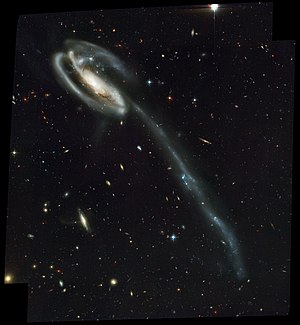Tadpole Galaxy
| Tadpole Galaxy | |
|---|---|
 The Tadpole Galaxy recorded with the Hubble Space Telescope's Advanced Camera for Surveys | |
| Observation data (J2000 epoch) | |
| Constellation | Draco |
| Right ascension | 16h 06m 03.9s[1] |
| Declination | +55° 25′ 32″[1] |
| Redshift | 9401 ± 15 km/s[1] |
| Distance | 400 Mly |
| Apparent magnitude (V) | 14.4[1] |
| Characteristics | |
| Type | SB(s)c pec[1] |
| Apparent size (V) | 3′.6 × 0′.8[1] |
| Notable features | Collided galaxy |
| Other designations | |
| UGC 10214,[1] Arp 188,[1] PGC 57129[1] | |
The Tadpole Galaxy is a disrupted barred spiral galaxy located 420 million light-years from Earth toward the northern constellation Draco. Its most dramatic features are a trail of stars about 280,000 light-years long and massive, bright blue star clusters.
It is hypothesized that a more compact intruder galaxy crossed in front of the Tadpole Galaxy—from left to right from the perspective of Earth—and was slung around behind the Tadpole by their mutual gravitational attraction. During this close encounter, tidal forces drew out the spiral galaxy's stars, gas, and dust, forming the conspicuous tail. The intruder galaxy itself, estimated to lie about 300 thousand light-years behind the Tadpole, can be seen through foreground spiral arms at the upper left. Following its terrestrial namesake, the Tadpole Galaxy will likely lose its tail as it grows older, the tail's star clusters forming smaller satellites of the large spiral galaxy.
References
- NASA - This article contains text from NASA, which is in the public domain.
